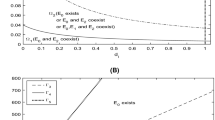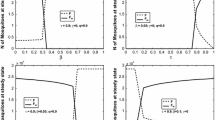Abstract
In this paper, we formulate a new \({{Wolbachia }}\) infection model in a two-sex mosquito population with stage structure. Some key factors of \({{Wolbachia }}\) infection, including cytoplasmic incompatibility (CI), male killing (MK) effect, maternal transmission, fecundity cost due to fitness effect and different mortality rates for infected individuals, are captured. Dynamical analysis has been carried out, and the basic reproduction number \(R_0\) for \({{Wolbachia }}\) infection has been calculated. Our analysis shows that \({{Wolbachia }}\) can establish in a mosquito population if \(R_0\) is greater than unity. If \(R_0\) is less than unity, \({{Wolbachia }}\) establishment still can be achieved if backward bifurcation occurs. Under this circumstance, the initial values lying in the basin of attraction of the stable \({{Wolbachia }}\)-established equilibrium are essential to guarantee \({{Wolbachia }}\) establishment. In particular, the method to find the basin of attraction and evaluate the threshold initial values is given. Besides, according to a comparison of different releasing strategies, it is shown that, from the perspective of economy and disease control, keeping the number of infected female mosquitoes to a necessary minimum by relying on higher number of male mosquitoes released is a desirable strategy. Moreover, global and local sensitivity analysis and numerical simulation have been performed to explore the impact of model parameters to the success of population establishment. Our results suggest that low levels of MK effect and fitness costs as well as high levels of CI and maternal inheritance are in favor of \({{Wolbachia }}\) establishment. Moreover, not considering MK effect and incomplete CI effect may result in the underestimation of the number of infected mosquitoes needed to be released.













Similar content being viewed by others
References
Becker N, Petric D, Boase C, Lane J, Zgomba M, Dahl C, Kaiser A (2003) Mosquitoes and their control, vol 2. Springer, Berlin
Bian G, Xu Y, Lu P, Xie Y, Xi Z (2010) The endosymbiotic bacterium \({{\mathit{Wolbachia}}}\) induces resistance to dengue virus in aedes aegypti. PLoS Pathog 6(4):e1000833
Bliman PA, Aronna MS, Coelho FC, Da Silva MA (2018) Ensuring successful introduction of Wolbachia in natural populations of Aedes aegypti by means of feedback control. J Math Biol 76(5):1269–1300
Campo-Duarte DE, Vasilieva O, Cardona-Salgado D, Svinin M (2018) Optimal control approach for establishing wMelPop Wolbachia infection among wild Aedes aegypti populations. J Math Biol 76(7):1907–1950
Cannavó F (2012) Sensitivity analysis for volcanic source modeling quality assessment and model selection. Comput Geosci 44:52–59
Caspari E, Watson G (1959) On the evolutionary importance of cytoplasmic sterility in mosquitoes. Evolution 13(4):568–570
Chan MH, Kim PS (2013) Modelling a Wolbachia invasion using a slow–fast dispersal reaction–diffusion approach. Bull Math Biol 75(9):1501–1523
Delatte H, Gimonneau G, Triboire A, Fontenille D (2009) Influence of temperature on immature development, survival, longevity, fecundity, and gonotrophic cycles of Aedes albopictus, vector of Chikungunya and Dengue in the Indian Ocean. J Med Entomol 46(1):33–41
Dorigatti I, McCormack C, Nedjati-Gilani G, Ferguson NM (2018) Using Wolbachia for dengue control: insights from modelling. Trends Parasitol 34(2):102–113
Egas M, Vala F, Breeuwer JAJ (2002) On the evolution of cytoplasmic incompatibility in haplodiploid species. Evolution 56(6):1101–1109
Engelstädter J, Telschow A, Hammerstein P (2004) Infection dynamics of different Wolbachia-types within one host population. J Theor Biol 231(3):345–355
Fang J, Gourley SA, Lou Y (2016) Stage-structured models of intra-and inter-specific competition within age classes. J Differ Equ 260(2):1918–1953
Farkas JZ, Gourley SA, Liu R, Yakubu A-A (2017) Modelling Wolbachia infection in a sex-structured mosquito population carrying west nile virus. J Math Biol 75(3):621–647
Farkas JZ, Hinow P (2010) Structured and unstructured continuous models for Wolbachia infections. Bull Math Biol 72(8):2067–2088
Fenton A, Johnson KN, Brownlie JC, Hurst GD (2011) Solving the Wolbachia paradox: modeling the tripartite interaction between host, Wolbachia, and a natural enemy. Am Nat 178(3):333–342
Hancock PA, Sinkins SP, Godfray HCJ (2011) Population dynamic models of the spread of Wolbachia. Am Nat 177(3):323–333
Hethcote HW (2000) The mathematics of infectious diseases. SIAM Rev 42(4):599–653
Hilgenboecker K, Hammerstein P, Schlattmann P, Telschow A, Werren JH (2008) How many species are infected with Wolbachia? A statistical analysis of current data. FEMS Microbiol Lett 281(2):215–220
Hu L, Tang M, Wu Z, Xi Z, Yu J (2018) The threshold infection level for Wolbachia invasion in random environments. J Differ Equ. https://doi.org/10.1016/j.jde.2018.09.035
Hughes H, Britton NF (2013) Modelling the use of Wolbachia to control dengue fever transmission. Bull Math Biol 75(5):796–818
Jiggins FM (2017) The spread of Wolbachia through mosquito populations. PLoS Biol 15(6):e2002780. https://doi.org/10.1371/journal.pbio.2002780
Joshi D, McFadden MJ, Bevins D, Zhang F, Xi Z (2014) Wolbachia strain w AlbB confers both fitness costs and benefit on Anopheles stephensi. Parasites Vectors 7(1):336
Keeling MJ, Jiggins F, Read JM (2003) The invasion and coexistence of competing Wolbachia strains. Heredity 91(4):382
Koiller J, Silva MD, Souza M, Codeço C, Iggidr A et al. (2014) Aedes, Wolbachia and Dengue. [Research Report] RR-8462, Inria Nancy - Grand Est (Villers-lès-Nancy, France). 47. https://hal.inria.fr/hal-00939411/document
Laven H (1951) Crossing experiments with culex strains. Evolution 5(4):370–375
Li J (2017) New revised simple models for interactive wild and sterile mosquito populations and their dynamics. J Biol Dyn 11(sup2):316–333
Li MT, Sun GQ, Yakob L, Zhu HP, Jin Z, Zhang WY (2016) The driving force for 2014 dengue outbreak in Guangdong, China. PloS one 11(11):e0166211
McMeniman CJ, Lane RV, Cass BN, Fong AW, Sidhu M, Wang Y-F, Oneill SL (2009) Stable introduction of a life-shortening Wolbachia infection into the mosquito aedes aegypti. Science 323(5910):141–144
Munga S, Minakawa N, Zhou G, Githeko AK, Yan G (2007) Survivorship of immature stages of anopheles gambiae sl (Diptera: Culicidae) in natural habitats in Western Kenya highlands. J Med Entomol 44(5):758–764
Ndii MZ, Hickson RI, Allingham D, Mercer G (2015) Modelling the transmission dynamics of dengue in the presence of Wolbachia. Math Biosci 262:157–166
Ndii MZ, Hickson RI, Mercer GN (2012) Modelling the introduction of Wolbachia into Aedes aegypti mosquitoes to reduce dengue transmission. ANZIAM J 53(3):213–227
O’Neill SL, Giordano R, Colbert A, Karr TL, Robertson HM (1992) 16S rRNA phylogenetic analysis of the bacterial endosymbionts associated with cytoplasmic incompatibility in insects. Proc Natl Acad Sci 89(7):2699–2702
Sallet G, Silva Moacyr AHB (2015) Monotone dynamical systems and some models of Wolbachia in Aedes aegypti populations. Revue Africaine de la Recherche en Informatique et Mathématiques Appliquées, INRIA, 20:145-176. https://hal.inria.fr/hal-01320616/document
Saltelli A, Annoni P, Azzini I, Campolongo F, Ratto M, Tarantola S (2010) Variance based sensitivity analysis of model output. Design and estimator for the total sensitivity index. Comput Phys Commun 181(2):259–270
Sarrazin F, Pianosi F, Wagener T (2016) Global sensitivity analysis of environmental models: convergence and validation. Environ Model Softw 79:135–152
Schofield P (2002) Spatially explicit models of turelli-hoffmann Wolbachia invasive wave fronts. J Theor Biol 215(1):121–131
Schraiber JG, Kaczmarczyk AN, Kwok R, Park M, Silverstein R, Rutaganira FU, Aggarwal T, Schwemmer MA, Hom CL, Grosberg RK et al (2012) Constraints on the use of lifespan-shortening Wolbachia to control dengue fever. J Theor Biol 297:26–32
Sobol IM (2001) Global sensitivity indices for nonlinear mathematical models and their monte carlo estimates. Math Comput Simul 55(1):271–280
Turelli M, Barton NH (2017) Deploying dengue-suppressing Wolbachia: robust models predict slow but effective spatial spread in Aedes aegypti. Theor Popul Biol 115:45–60
Van den Driessche P, Watmough J (2002) Reproduction numbers and sub-threshold endemic equilibria for compartmental models of disease transmission. Math Biosci 180(1):29–48
Walker T, Johnson PH, Moreira LA, Iturbe-Ormaetxe I, Frentiu FD et al (2011) The wMel Wolbachia strain blocks dengue and invades caged Aedes aegypti populations. Nature 476:450–453
Wang L, Zhao H, Oliva SM, Zhu H (2017) Modeling the transmission and control of Zika in Brazil. Sci Rep 7(1):7721
Werren JH (1997) Biology of Wolbachia. Annu Rev Entomol 42(1):587–609
Werren JH, Windsor DM (2000) Wolbachia infection frequencies in insects: evidence of a global equilibrium? Proc R Soc Lond B: Biol Sci 267(1450):1277–1285
Xue L, Manore CA, Thongsripong P, Hyman JM (2017) Two-sex mosquito model for the persistence of Wolbachia. J Biol Dyn 11(sup1):216–237
Yen JH, Barr AR (1971) New hypothesis of the cause of cytoplasmic incompatibility in Culex pipiens L. Nature 232(5313):657–658
Zhang X, Tang S, Cheke RA (2015) Birth-pulse models of Wolbachia-induced cytoplasmic incompatibility in mosquitoes for dengue virus control. Nonlinear Anal: Real World Appl 22:236–258
Zhang X, Tang S, Cheke RA (2015) Models to assess how best to replace dengue virus vectors with Wolbachia-infected mosquito populations. Math Biosci 269:164–177
Zhang X, Tang S, Cheke RA, Zhu H (2016) Modeling the effects of augmentation strategies on the control of dengue fever with an impulsive differential equation. Bull Math Biol 78(10):1968–2010
Zheng B, Tang M, Yu J (2014) Modeling \({{\mathit{Wolbachia}}}\) spread in mosquitoes through delay differential equations. SIAM J Appl Math 74(3):743–770
Acknowledgements
Dan Li is supported by the National Natural Science Foundation of China (No. 11801209) and the Natural Science Foundation of the Jiangsu Higher Education Institutions of China (No. 18KJB110004). Hui Wan is supported by the Jiangsu Overseas Research and Training Program for University Prominent Young and Middle-aged Teachers and Presidents, the NSF of the Jiangsu Higher Education Committee of China (No. 17KJA110002) and a project funded by PAPD of Jiangsu Higher Education Institutions. The authors thank two reviewers and Prof. Guihong Fan for very helpful suggestions and comments.
Author information
Authors and Affiliations
Corresponding author
Additional information
Publisher's Note
Springer Nature remains neutral with regard to jurisdictional claims in published maps and institutional affiliations.
Rights and permissions
About this article
Cite this article
Li, D., Wan, H. The Threshold Infection Level for \({{Wolbachia }}\) Invasion in a Two-Sex Mosquito Population Model. Bull Math Biol 81, 2596–2624 (2019). https://doi.org/10.1007/s11538-019-00620-1
Received:
Accepted:
Published:
Issue Date:
DOI: https://doi.org/10.1007/s11538-019-00620-1
Keywords
- \({{Wolbachia }}\)
- Mosquito population
- Two-sex model
- Sensitivity analysis
- Backward bifurcation
- Releasing strategy




